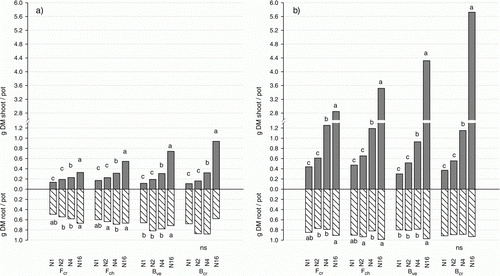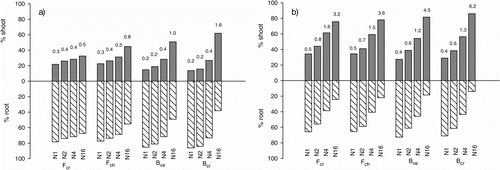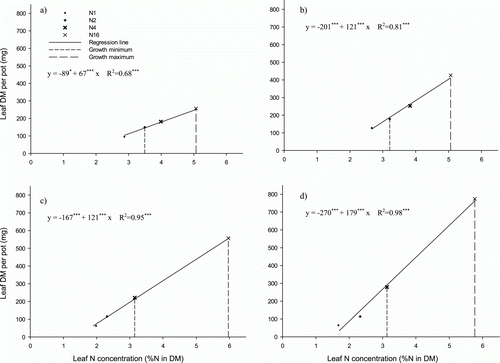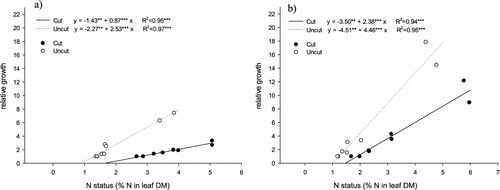Figures & data
Table I. Amounts of elements in the nutrient solution used in experiments (Wallco 51-10-43 + microa).
Figure 1. Shoot and root biomass per pot (g dry matter, DM) of the different grass varieties (Fcr=red fescue var. ‘Cezanne’, Fch=red fescue var. ‘Center’, Bve=velvet bentgrass var. ‘Legendary’, Bcr=creeping bentgrass var. ‘Independence’), at different fertilization regimes (N1, N2, N4, N16 = 12.5, 25, 50, and 200 mg N L−1 respectively in the irrigation water) for (a) cut and (b) uncut grass. Different small letters show significant differences in root and shoot biomass, respectively, between different N fertilization regimes within the four grass species (α = 0.05). ns = not significant.

Figure 2. Biomass partitioning (% shoot and root of total biomass) and shoot:root ratio (values on top of each bar) of (a) cut and (b) uncut turf grass species at the different N fertilization levels. Abbreviations as in .

Figure 3. Nitrogen concentrations in leaves (%) of the (a) cut and (b) uncut turf grass species at the different N fertilization levels. Vertical bars show LSD at α = 0.05. Abbreviations as in .

Figure 4. Correlation between leaf N concentration and leaf biomass production after 3 weeks at the different N fertilization rates for the cut turf grass species (a) Fcr, (b) Fch, (c) Bve and (d) Bcr and the N concentration at the lowest growth rate showing no pronounced deficiency symptoms (growth minimum) and highest growth rate achieved in this experiment (growth maximum). Abbreviations as in . Symbols show means of six replicates for the cut and four replicates for the uncut treatment.

Table II. Content of carbohydrates (% of DM) in clippings (pooled samples) from creeping bentgrass, Bcr, and slender creeping red fescue, Fcr, at different N fertilization levels, 12.5 (N1), 25 (N2), 50 (N4) and 200 (N16) mg N L−1 irrigation water.
Figure 5. Correlations between leaf N concentration of the grasses (%N in DM) and their relative aboveground biomass growth (growth at N1, N2, N4, and N16 in relation to N1) for the cut and uncut (a) fescue species (Fch and Fcr) and (b) bentgrass species (Bcr and Bve). Abbreviations as in . Symbols show means of six replicates for the cut and four replicates for the uncut treatment.
